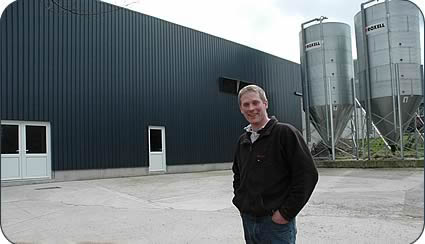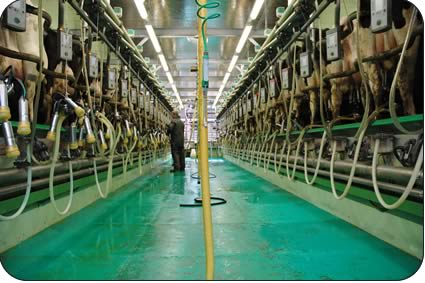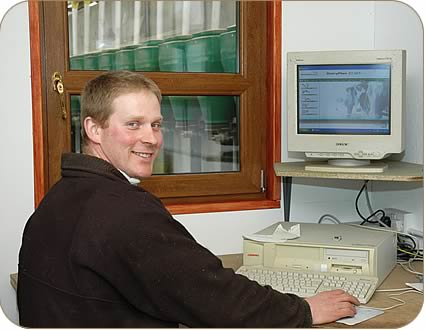Jennifer MacKenzie is an agricultural photo journalist with almost 30 year's experience. Operating from her base in Cumbria, Jennifer undertakes mainly industry-related freelance writing and photography.
First floor milking parlour reaps rewards
A six figure investment in a two storey dairy building and new milking and feeding equipment is already reaping rewards in terms of efficiencies in work time and increased yields for producer Michael Wilson.
 |
| Michael Wilson outside the dairy building |
Michael who milks 270 pedigree Holsteins in partnership with his parents Robin and Jean wanted to make further investments in buildings and equipment at Woodside Farm, Wreay, near Carlisle, to update the bulk tank and milking parlour which had come to the end of its useful life after almost 30 years.
Constraints placed on further developments of the farm steading by the West Coast main line railway which borders one side and a sloping site which falls by around two metres, led Michael to build a two storey building on an area formerly occupied by a slurry store before a new lagoon was built.
The north end of the 16 metre by 46 metre long building is infill beneath the collecting yard which links up with a single span feeding shed which was built in 1999.
The south end of the building houses the new 48 x 48 Westfalia herringbone parlour on the first floor which is also attached to existing cubicle accommodation converted from a former silage clamp three years ago and cubicles renewed eight years ago now also housing the recently installed 12 station out-of-parlour feeders. The new building has an office in the loft space where there is access to the in-parlour feeders.
 |
| New parlour at Woodside Farm |
At ground level beneath the parlour is a new 28,000 litre Mueller DX bulk milk tank. Specialist milking machine and equipment suppliers GD and M Dunglinson, of Brunstock, Carlisle, carried out all the installations.
Michael Wilson had looked at numerous parlour designs before settling on another herringbone. He had considered a rotary parlour but because of the sloping site a lot of ground would have had to be built up.
The herringbone fitted well with the site and saved on investment cost. Michael had also decided that there were likely to be more potential mechanical problems with the rotary parlour’s rotating concrete doughnut.
He had also considered a rapid exit parlour however this would have made feeding in parlour difficult, which he wanted to maintain to keep the cows quiet.
“Although we had been milking upwards of 250 cows for a few years, our old 24 x 24 parlour was not adequate and the milking time was too long.
“Prior to foot and mouth in 2001 when we lost our herd we had been milking just short of 300 cows. At the moment we’re milking 270 and we may possibly increase that by another 20 or 30 cows but no more.
“With our old parlour our cowman Ian Teasdale would take almost four hours from starting milking at 4.30am to get all the cows through. The afternoon milking from 2.30pm took three and a half hours. Now we start later in the morning and afternoon.
“Now all the cows can be milked in a little under two hours,” said Mr Wilson, who also has help in the parlour from tractor man Graeme Mcaleese and self-employed milker George Faulder to ensure there are two people involved.
“From a welfare point of view alone it’s a lot better for the cows as they are not standing in the collection yard for so long,” he added.
 |
| Michael Wilson at his computer |
The milking and feeding system frees up time for other tasks around the farm as well as enabling Michael who with his wife Suzanne has three young children – Laurence, five, Henry, three and Emma, one - to spend more time at weekends with the family.
Cows in the Wreaywood herd were traditionally fed in the parlour, but since the out of parlour feeders were installed 11 months ago, the system has allowed much more flexibility to feed to yield.
During the winter the cows are trough fed three times a week to keep work to a minimum with a mix of 75 per cent grass silage with 25 per cent fermented wheat wholecrop. Two thirds of the concentrate ration is fed out of parlour with the remainder in parlour.
“Prior to using the out of parlour feeders we were able to feed for up to 37 litres but any that were yielding over that were losing weight. With the new system we can feed to yield – we usually have about 10 cows which are giving over 50 litres and currently the herd is averaging 29 litres a cow a day with an annual average of around 9,000 litres.
“Ian has always looked after the breeding, concentrating on type and production for the herd through AI and now by improving the feeding we are making the most of those genetics.
“Since using the out of parlour feeders we have lifted production by up to 1,400 litres a cow. As a result, the feeders will have paid for themselves within 18 months.”
The new parlour is fitted with P21 Metatron milk meters and yields and a range of other cow data is monitored through Westfalia’s Dairyplan herd management programme with feeds adjusted accordingly.
The cows are fed concentrate to yield up to a maximum of 3kg in the parlour at each milking to avoid any being left over for the next cow.
The lowest yielding cows are fed only in the parlour. The highest yielders are fed up to an additional 15kg in the out of parlour feeders. Total concentrate use for a year is currently averaging 3.1 tonnes a cow.
Separate feed hoppers have been erected for the in and out of parlour feeders to enable two different concentrates to be fed.
In early April the in-parlour feed was 21 per cent protein with 20 per cent in the out of parlour feeders alongside second cut silage. With first cut, the protein content would be decreased to balance the ration.
After turnout depending on grass quality, the protein will be further reduced to 16 per cent, according to milk quality.
“I had looked at TMR wagons at the time of upgrading buildings in the 1990s but at the time it looked like it was going to take up a man’s time for three hours every day mixing seven loads of feed. On the system we are operating now, every cow is fed as an individual and the value of our higher yielders is optimised.
“The investments we have made allow us to make the most of the advantage of scale we have. As far as business security goes, I don’t think dairy farming is too bad. I think there will always be a market for dairy products and in the longer term, higher fuel prices are likely to make imports dearer.”
An automatic shedding gate accessed through footbaths at the parlour exit is also linked to the computer system so that where necessary cows can be separated from the rest of the herd for treatment and other purposes.
A separate race alongside the parlour has been built for TB testing where cows can be held securely.
The new bulk tank replaces the former 8,000 litre tank installed 16 years ago, which now allows every other day collection by First Milk.
“I chose this size as it’s the same capacity as an articulated milk tanker and it would hold as much milk as I was likely to produce.
It puts me in a better position to negotiate milk contracts and it also saves on washing out costs with every other day collection.
“The Mueller system is simple based on a plate cooler which means there is less to go wrong.”
Also saving on time is the plant’s automated wash-down system.
Cow numbers currently total 320 with a further 180 youngstock. The farm, which was purchased by Michael’s grandfather in 1966, runs to 450 acres with a further 40 acres of land rented during the summer.
The farm’s only other livestock are up to 400 easily managed Cheviot store lambs which are bought in and kept over the winter.

